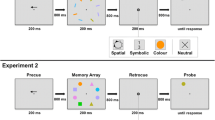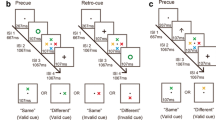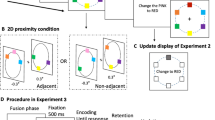Abstract
Previous research has shown that visual working memory (VWM) can be modulated by space-based or feature-based attentional selection. However, it remains unclear how the two modes of attention operate jointly to affect VWM, and in particular, if involuntary feature-based attention plays a role in VWM. In this study, a pre-cued change detection paradigm was employed to investigate the concurrent effects of space- and feature-based attention on VWM. Space-based attention was manipulated by informative spatial cueing and by varying the proximity between the test item and the cued (fixated) memory item, while feature-based attention was induced in an involuntary manner by having the test item to share the same color or shape with the cued item on a fraction of trials. The results showed that: (1) the memory performance for the cued items was always better than the uncued items, suggesting a beneficial effect of voluntary spatial attention; (2) with a brief duration of the memory array (250 ms), cue-test proximity benefited VWM in the shape judgment task but not in the color judgment task, whereas with a longer duration (1200 ms), no proximity effect was found for either task; (3) VWM was improved for the same-colored items regardless of the task and duration; (4) VWM was improved for the same-shaped items only in the shape judgment task with the longer duration of the memory array. A discrimination task further showed that the proximity effect associated with VWM reflects a perceptual bottleneck in memory encoding for shape but not for color with a brief display. Our results suggest that involuntary feature-based attention could be triggered by spatial cueing to modulate VWM; involuntary color-based attention facilitates VWM independently of task, whereas shape-based facilitation is task–dependent, i.e., confined only to the shape judgment task, presumably reflecting different attention-guiding potencies of the two features.






Similar content being viewed by others
References
Alvarez, G. A., & Cavanagh, P. (2004). The capacity of visual short-term memory is set both by visual information load and by number of objects. Psychological Science, 15(2), 106–111.
Astle, D. E., Summerfield, J., Griffin, I., & Nobre, A. C. (2012). Orienting attention to locations in mental representations. Attention, Perception, & Psychophysics, 74(1), 146–162.
Awh, E., Barton, B., & Vogel, E. K. (2007). Visual working memory represents a fixed number of items regardless of complexity. Psychological Science, 18(7), 622–628.
Ben-Av, M. B., & Sagi, D. (1995). Perceptual grouping by similarity and proximity: Experimental results can be predicted by intensity autocorrelations. Vision Research, 35(6), 853–866.
Berryhill, M. E., Richmond, L. L., Shay, C. S., & Olson, I. R. (2012). Shifting attention among working memory representations: Testing cue type, awareness, and strategic control. Quarterly Journal of Experimental Psychology, 65(3), 426–438.
Broadbent, D. (1982). Task combination and selective intake of information. Acta Psychologica, 50, 253–290.
Carrasco, M. (2011). Visual attention: The past 25 years. Vision research, 51(13), 1484–1525.
Chun, M. M., & Jiang, Y. (1998). Contextual cueing: Implicit learning and memory of visual context guides spatial attention. Cognitive Psychology, 36(1), 28–71.
Cowan, N. (2001). Metatheory of storage capacity limits. Behavioral and Brain Sciences, 24(01), 154–176.
Cowan, N., Naveh-Benjamin, M., Kilb, A., & Saults, J. S. (2006). Life-span development of visual working memory: When is feature binding difficult? Developmental Psychology, 42(6), 1089.
Deubel, H., & Schneider, W. X. (1996). Saccade target selection and object recognition: Evidence for a common attentional mechanism. Vision Research, 36(12), 1827–1837.
Driver, J., & Spence, C. (1998). Attention and the crossmodal construction of space. Trends in Cognitive Sciences, 2(7), 254–262.
Duncan, J. (1984). Selective attention and the organization of visual information. Journal of Experimental Psychology: General, 113(4), 501.
Egly, R., Driver, J., & Rafal, R. D. (1994). Shifting visual attention between objects and locations: evidence from normal and parietal lesion subjects. Journal of Experimental Psychology: General, 123(2), 161.
Eimer, M. (2014). The neural basis of attentional control in visual search. Trends in Cognitive Sciences, 18(10), 526–535.
Engbert, R., Longtin, A., & Kliegl, R. (2002). A dynamical model of saccade generation in reading based on spatially distributed lexical processing. Vision Research, 42(5), 621–636.
Eriksen, C. W., & Hoffman, J. E. (1973). The extent of processing of noise elements during selective encoding from visual displays. Perception & Psychophysics, 14(1), 155–160.
Eriksen, C. W., & James, J. D. S. (1986). Visual attention within and around the field of focal attention: A zoom lens model. Perception & Psychophysics, 40(4), 225–240.
Eriksen, C. W., & Yeh, Y. (1985). Allocation of attention in the visual field. Journal of Experimental Psychology: Human Perception and Performance, 11(5), 583.
Faul, F., Erdfelder, E., Lang, A.-G., & Buchner, A. (2007). G*power 3: A flexible statistical power analysis program for the social, behavioral, and biomedical sciences. Behavior Research Methods, 39, 175–191.
Fine, M. S., & Minnery, B. S. (2009). Visual salience affects performance in a working memory task. Journal of Neuroscience, 29(25), 8016–8021.
Foerster, R. M., & Schneider, W. X. (2018). Involuntary top-down control by search-irrelevant features: Visual working memory biases attention in an object-based manner. Cognition, 172, 37–45.
Folk, C. L., & Remington, R. (1998). Selectivity in distraction by irrelevant featural singletons: Evidence for two forms of attentional capture. Journal of Experimental Psychology: Human Perception and Performance, 24, 847–858.
Fougnie, D., Asplund, C. L., & Marois, R. (2010). What are the units of storage in visual working memory? Journal of Vision, 10(12), 27–27.
Gazzaley, A., & Nobre, A. C. (2012). Top-down modulation: bridging selective attention and working memory. Trends in Cognitive Sciences, 16(2), 129–135.
Griffin, I. C., & Nobre, A. C. (2003). Orienting attention to locations in internal representations. Journal of Cognitive Neuroscience, 15(8), 1176–1194.
Hawkins, H. L., Hillyard, S. A., Luck, S. J., Mouloua, M., Downing, C. J., & Woodward, D. P. (1990). Visual attention modulates signal detectability. Journal of Experimental Psychology: Human Perception and Performance, 16, 802–811.
Heuer, A., & Schubö, A. (2016). Feature-based and spatial attentional selection in visual working memory. Memory & Cognition, 44(4), 621–632.
Heuer, A., Schubö, A., & Crawford, J. (2016). Different cortical mechanisms for spatial vs. feature-based attentional selection in visual working memory. Frontiers in Human Neuroscience, 10, 415.
Hollingworth, A., & Beck, V. M. (2016). Memory-based attention capture when multiple items are maintained in visual working memory. Journal of Experimental Psychology: Human Perception and Performance, 42(7), 911.
Huang, L., & Pashler, H. (2007). A boolean map theory of visual attention. Psychological Review, 114(3), 599.
Huffman, G., Al-Aidroos, N., & Pratt, J. (2015). The interaction between spatial cueing and cue-target feature similarity. Journal of Vision, 15, 895.
Janczyk, M., & Reuss, H. (2016). Only pre-cueing but no retro-cueing effects emerge with masked arrow cues. Consciousness and Cognition, 42, 93–100.
Jiang, Y., Chun, M. M., & Olson, I. R. (2004). Perceptual grouping in change detection. Perception & Psychophysics, 66(3), 446–453.
Johansson, R., & Johansson, M. (2014). Look here, eye movements play a functional role in memory retrieval. Psychological Science, 25(1), 236–242.
Kalogeropoulou, Z., Jagadeesh, A. V., Ohl, S., & Rolfs, M. (2017). Setting and changing feature priorities in visual short-term memory. Psychonomic Bulletin & Review, 24(2), 453–458.
Kanwisher, N., & Driver, J. (1992). Objects, attributes, and visual attention: Which, what, and where. Current Directions in Psychological Science, 1(1), 26–31.
Lambert, A. J., & Hockey, R. (1986). Selective attention and performance with a multidimensional visual display. Journal of Experimental Psychology: Human Perception and Performance, 12(4), 484.
Lamy, D., & Tsal, Y. (2000). Object features, object locations, and object files: Which does selective attention activate and when? Journal of Experimental Psychology: Human Perception and Performance, 26(4), 1387.
Lamy, D., & Tsal, Y. (2001). On the status of location in visual attention. European Journal of Cognitive Psychology, 13(3), 305–342.
Landman, R., Spekreijse, H., & Lamme, V. A. (2003). Large capacity storage of integrated objects before change blindness. Vision research, 43(2), 149–164.
Lavie, N., & Driver, J. (1996). On the spatial extent of attention in object-based visual selection. Perception & Psychophysics, 58(8), 1238–1251.
Li, J., Qian, J., & Liang, F. (2018). Evidence for the beneficial effect of perceptual grouping on visual working memory: an empirical study on illusory contour and a meta-analytic study. Scientific Reports, 8(1), 13864.
Li, Q., & Saiki, J. (2015). Different effects of color-based and location-based selection on visual working memory. Attention, Perception, & Psychophysics, 77(2), 450–463.
Liu, T., Beckera, M. W., & Jigoa, M. (2013). Limited featured-based attention to multiple features. Vision Research, 85(7), 36–44.
Luck, S. J., & Vogel, E. K. (1997). The capacity of visual working memory for features and conjunctions. Nature, 390(6657), 279–281.
Makovski, T., Sussman, R., & Jiang, Y. V. (2008). Orienting attention in visual working memory reduces interference from memory probes. Journal of Experimental Psychology: Learning, Memory, and Cognition, 34(2), 369.
Martinez-Trujillo, J. C., & Treue, S. (2004). Feature-based attention increases the selectivity of population responses in primate visual cortex. Current Biology, 14, 744–751.
Matsukura, M., Luck, S. J., & Vecera, S. P. (2007). Attention effects during visual short-term memory maintenance: protection or prioritization? Perception & Psychophysics, 69(8), 1422–1434.
McMains, S. A., Fehd, H. M., Emmanouil, T.-A., & Kastner, S. (2007). Mechanisms of feature-and space-based attention: response modulation and baseline increases. Journal of Neurophysiology, 98(4), 2110–2121.
Melcher, D., & Piazza, M. (2011). The role of attentional priority and saliency in determining capacity limits in enumeration and visual working memory. PLoS One, 6(12), e29296.
Moorselaar, D., Battistoni, E., Theeuwes, J., & Olivers, C. N. (2015). Rapid influences of cued visual memories on attentional guidance. Annals of the New York academy of Sciences, 1339(1), 1–10.
Mozer, M. C. (2002). Frames of reference in unilateral neglect and visual perception: a computational perspective. Psychological Review, 109(1), 156.
Mozer, M. C., & Vecera, S. P. (2005). Space-and object-based attention. Neurobiology of attention. New York: Elsevier, pp. 130–134).
Muller, H. J., & Findlay, J. M. (1987). Sensitivity and criterion effects in the spatial cuing of visual attention. Perception & Psychophysics, 42, 383–399.
Muller, H. J., & Rabbit, P. M. A. (1989). Reflexive and voluntary orienting of visual attention: Time course of activation and resistance to interruption. Journal of Experimental Psychology: Human Perception and Performance, 15, 315–330.
Murray, A. M., Nobre, A. C., Clark, I. A., Cravo, A. M., & Stokes, M. G. (2013). Attention restores discrete items to visual short-term memory. Psychological Science, 24(4), 550–556.
Myers, N. E., Stokes, M. G., & Nobre, A. C. (2017). Prioritizing information during working memory: beyond sustained internal attention. Trends in Cognitive Sciences, 21(6), 449–461.
Niklaus, M., Nobre, A. C., & Van Ede, F. (2017). Feature-based attentional weighting and spreading in visual working memory. Scientific reports, 7, 42384.
Nobre, A. C., Coull, J., Maquet, P., Frith, C., Vandenberghe, R., & Mesulam, M. (2004). Orienting attention to locations in perceptual versus mental representations. Journal of Cognitive Neuroscience, 16(3), 363–373.
Ohl, S., & Rolfs, M. (2017). Saccadic eye movements impose a natural bottleneck on visual short-term memory. Journal of Experimental Psychology: Learning, Memory, and Cognition, 43(5), 736.
Olivers, C. N., Meijer, F., & Theeuwes, J. (2006). Feature-based memory-driven attentional capture: visual working memory content affects visual attention. Journal of Experimenta Psychology: Human Perception and Performance, 32(5), 1243.
Olsen, R. K., Chiew, M., Buchsbaum, B. R., & Ryan, J. D. (2014). The relationship between delay period eye movements and visuospatial memory. Journal of Vision, 14(1), 8–8.
Pashler, H. (1988). Familiarity and visual change detection. Perception & Psychophysics, 44(4), 369–378.
Pedale, T., & Santangelo, V. (2015). Perceptual salience affects the contents of working memory during free-recollection of objects from natural scenes. Frontiers in Human Neuroscience, 9, 60.
Pertzov, Y., Bays, P. M., Joseph, S., & Husain, M. (2013). Rapid forgetting prevented by retrospective attention cues. Journal of Experimental Psychology: Human Perception and Performance, 39(5), 1224.
Peterson, D. J., & Berryhill, M. E. (2013). The gestalt principle of similarity benefits visual working memory. Psychonomic Bulletin & Review, 20(6), 1282–1289.
Posner, M. I. (1980). Orienting of attention. Quarterly Journal of Experimental Psychology, 32(1), 3–25.
Qian, J., Li, J., Wang, K., Liu, S., & Lei, Q. (2017). Evidence for the effect of depth on visual working memory. Scientific Reports, 7(1), 6408. https://doi.org/10.1038/s41598-017-06719-6.
Qian, J., Zhang, K., Wang, K., Li, J., & Lei, Q. (2018). Saturation and brightness modulate the effect of depth on visual working memory. Journal of Vision, 18(9), 16, 1–12.
Rolfs, M., & Carrasco, M. (2012). Rapid simultaneous enhancement of visual sensitivity and perceived contrast during saccade preparation. Journal of Neuroscience, 32(40), 13744–13752a.
Ryan, J. D., & Villate, C. (2009). Building visual representations: The binding of relative spatial relations across time. Visual Cognition, 17(1–2), 254–272.
Soto, D., Heinke, D., Humphreys, G. W., & Blanco, M. J. (2005). Early, involuntary top-down guidance of attention from working memory. Journal of Experimental Psychology: Human Perception and Performance, 31(2), 248.
Souza, A. S., & Oberauer, K. (2016). In search of the focus of attention in working memory: 13 years of the retro-cue effect. Attention, Perception, & Psychophysics, 78(7), 1839–1860.
Tanoue, R. T., & Berryhill, M. E. (2012). The mental wormhole: internal attention shifts without regard for distance. Attention, Perception, & Psychophysics, 74(6), 1199–1215.
Theeuwes, J. (1989). Effects of location and form cuing on the allocation of attention in the visual field. Acta Psychologica, 72(2), 177–192.
Thornton, T. L., & Gilden, D. L. (2007). Parallel and serial processes in visual search. Psychological Review, 114(1), 71.
Traxler, M. (2011). Introduction to psycholinguistics: Understanding language science. Hoboken: Wiley.
Vecera, S. P. (1994). Grouped locations and object-based attention: Comment on egly, driver, and rafal (1994). Journal of Experimental Psychology: General, 123(3), 316–320.
Vecera, S. P., & Farah, M. J. (1994). Does visual attention select objects or locations? Journal of Experimental Psychology: General, 123(2), 146.
Vogel, E. K., Woodman, G. F., & Luck, S. J. (2001). Storage of features, conjunctions, and objects in visual working memory. Journal of Experimental Psychology: Human Perception and Performance, 27(1), 92.
White, A. L., & Carrasco, M. (2011). Feature-based attention involuntarily and simultaneously improves visual performance across locations. Journal of Vision, 11(6), 15–15.
Williams, M., Pouget, P., Boucher, L., & Woodman, G. F. (2013). Visual–spatial attention aids the maintenance of object representations in visual working memory. Memory & Cognition, 41(5), 698–715.
Wolfe, J. M., & Horowitz, T. S. (2017). Five factors that guide attention in visual search. Nature Human Behaviour, 1(3), 0058.
Woodman, G. F., Vecera, S. P., & Luck, S. J. (2003). Perceptual organization influences visual working memory. Psychonomic Bulletin & Review, 10(1), 80–87.
Woodman, G. F., Vogel, E. K., & Luck, S. J. (2001). Visual search remains efficient when visual working memory is full. Psychological Science, 12(3), 219–224.
Xu, Y. (2002). Encoding color and shape from different parts of an object in visual short-term memory. Perception & Psychophysics, 64(8), 1260–1280.
Xu, Y. (2006). Understanding the object benefit in visual short-term memory: The roles of feature proximity and connectedness. Perception & Psychophysics, 68(5), 815–828.
Xu, Y., & Chun, M. M. (2007). Visual grouping in human parietal cortex. Proceedings of the National Academy of Sciences, 104(47), 18766–18771.
Zhang, W., & Luck, S. J. (2008). Discrete fixed-resolution representations in visual working memory. Nature, 453(7192), 233–235.
Zhuang, X., & Papathomas, T. V. (2011). Cue relevance effects in conjunctive visual search: Cueing for location, color, and orientation. Journal of Vision, 11(7), 6–6.
Baddeley, A. (2003). Working memory: looking back and looking forward. Nature Review Neuroscience, 4(10), 829–839.
Acknowledgements
This work has been supported in part by the National Natural Science Foundation of China (31500919). We thank Shengxi Liu for collecting data for Experiment 2.
Author information
Authors and Affiliations
Contributions
Conceived and designed the experiments: JQ. Performed the experiments: KZ, YH, WL. Analyzed the data: JQ. Wrote the paper: JQ, QL. Review the paper: JQ, QL.
Corresponding authors
Additional information
Publisher’s Note
Springer Nature remains neutral with regard to jurisdictional claims in published maps and institutional affiliations.
Rights and permissions
About this article
Cite this article
Qian, J., Zhang, K., Lei, Q. et al. Task-dependent effects of voluntary space-based and involuntary feature-based attention on visual working memory. Psychological Research 84, 1304–1319 (2020). https://doi.org/10.1007/s00426-019-01161-x
Received:
Accepted:
Published:
Issue Date:
DOI: https://doi.org/10.1007/s00426-019-01161-x




